How to Charge an RV Battery From Vehicle While Driving?
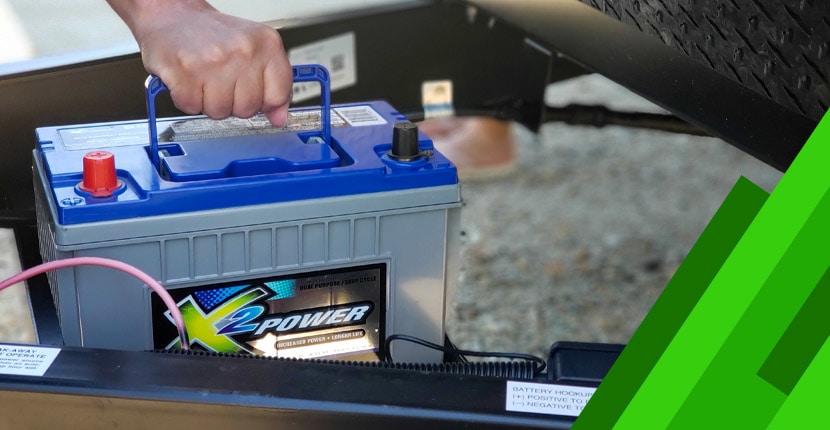
When we are going on a trip with our RV vehicle, we use home appliances, lighting fixtures, telephones, and TV, and all of them need electricity to work. That’s why it is very important that the batteries in your RV are always charged. There are a few ways on how you can charge your batteries, whether it’s an RV (recreational vehicle) like a trailer or an RV in question. Therefore, in this article, we’ll talk about how you can charge your RV battery and how you can boost speed. So, let’s start!
Table of Contents
How To Charge Your RV Battery While Driving?
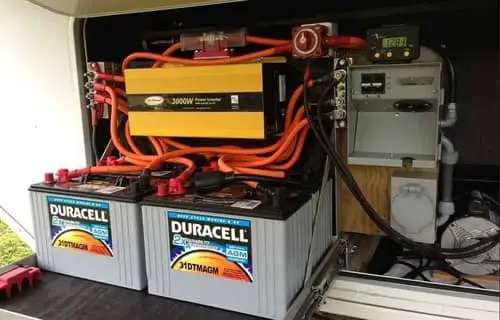
RV (recreational vehicle) battery can be charged while you are driving directly by using the vehicle’s power with the help of an alternator. For this, you need a 7-pin travel plug trailer. If you have an RV, you don’t have to worry, in most of these vehicles, the alternator can independently charge all the devices while driving. This is a very useful feature when you go on a short camping trip in the wild and have no electricity connections.
Tip: When you find yourself in a situation where you need to charge your RV battery, and your RV is already parked, use a portable generator. It is not recommended to use the vehicle alternator only to charge the batteries while you are parked.
Keep in mind that the batteries in your RV will not charge so quickly with the alternator while you’re driving your RV. In the best case, the batteries will be charged at a slow trickle. In the next section, we’ll learn why this process is so slow and how you can increase the process!
Also, be sure to read How To Turn On Electric Water Heater in RV if you want to learn more about RVs.
How Long Does The Charging Process Of an RV Battery Take?
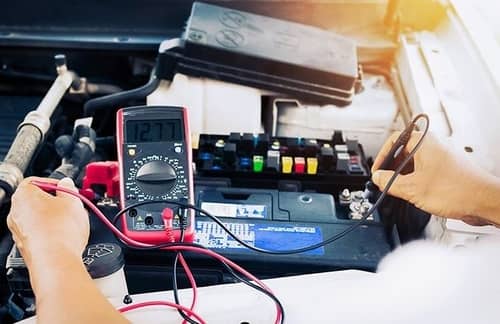
As mentioned earlier, charging your RV’s batteries with the help of an alternator is a slow process if you do it while driving. We will consider why this is so. But first, you need to know that recreational vehicles have two battery types.
- The initial battery (also called chassis battery) powers the vehicle and activates additional RV functions such as radio or lights. During vehicle operation, this battery is charged continuously.
- When the vehicle is not connected to a backup power source, a house battery or 12v battery located in your RV (lithium, lead-acid or deep cycle battery) takes care of charging everything that runs on electricity in your wheeled home environment.
When adding a 7-way connector plug that connects your vehicle and trailer, the base battery of your RV powers the brakes and all the lights in the vehicle.
This is why your vehicle’s base battery is slowly charging the RV battery. While the necessary electricity is used to charge the brakes and lights, which is a priority, there is not enough additional energy left to quickly charge the RV battery.
Fast Charging Method For the RV Battery
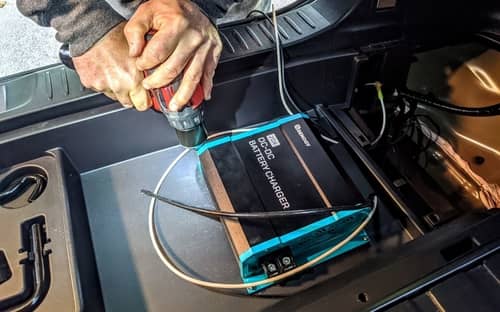
If you use a DC to DC charger, you can turn a slow RV battery charge into a fast and powerful charge! And this is on the principle of transforming dripping water into a jet that comes out of the garden watering hoses. A DC/DC battery charger is installed into the RV vehicle system like an electric pump that delivers much more electricity from the alternator to the RV battery and that way it significantly reduces the time required to charge the battery.
Without a battery charger, DC to DC charging powers your RV with a volume of 5 amps, while using DC to DC charging is done with a volume of 20 amps. Installing a battery DC to DC charger in your vehicle is not difficult, you just need a little knowledge of the electrical system inside the vehicle and some tools.
Keep in mind that when working on any vehicle’s electrical system, there is always the possibility of electrical shock. Therefore, be sure to study your device’s manual and take all the recommended precautions. To make the installation process easier for you below is a video that explains step by step the installation process of the Renogy DC to DC charger which is best and recommended for RV vehicles.
Important: If you think that you are not up to the task of self-installing the DC/DC charger to the RV vehicle, we recommend that you hire a professional for this job.
Below are general instructions on how you need to connect the wires in your truck to charge the battery in the RV faster with a DC to DC charger. However, keep in mind that these are general instructions and that it is recommended to always study in detail the manufacturer’s manual that comes with your vehicle.
Tip: Be sure to download Renogy DC to DC charger user manual for safe installation and more.
Why RV Battery Is Not Charging While Driving?
If you notice that the RV battery does not charge while driving, the most common reason is the problem with loose wiring or a bad solenoid. Make sure to check all the connections between the batteries and the alternator to detect the problem. The best way to do this is to check the wiring diagram of your vehicle model (you can download it from the internet).
When you checked all the current connections, test to see if you have a broken solenoid. This can be done by turning on your rig through the terminal. The voltage should be around 14V.
If everything is fine with your wiring and solenoids, then other reasons cause the batteries in your RV to stop charging. These include bad house batteries, blown fuse, bird relay issues or isolator issues on the battery, bad alternator, bad battery center for control center (BCC box), etc.
You need to check that the batteries and relays are fully functioning and that all fuses are working. If you notice a problem at this stage of the vehicle inspection, take your RV to a professional.
How To Choose The Best RV Battery
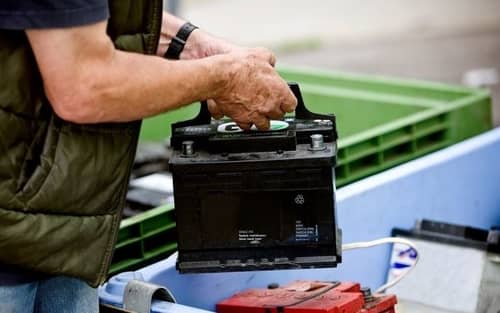
The market is flooded with different types of RV batteries, and each of these types has its pros and cons among campers. Here are the parameters that are important when it comes to choosing a quality RV battery:
- Deep-cycle batteries: are types of lead-acid batteries that are most commonly used in golf cars and boat vehicles. At first glance, they are standard car batteries because they work on the same chemical base that ensures energy retention. But they are still different. The Deep-cycle battery provides a constant power outlet for a long time, while a standard car battery can only retain the energy that is produced for a short time. This is because cars can always charge their battery while driving.
- Lithium batteries: are an alternative to lead-acid batteries, and are installed in most RV models. Their use is mainly promoted by campers who have converted their RV vehicles to use solar energy as well. Keep in mind that this type of battery has a number of advantages, such as: they are smaller and much lighter.
For those who want to learn more, be sure to read How To Hook Up TV To RV Antenna (Step-By-Step Guide).
Proper RV Battery Maintenance
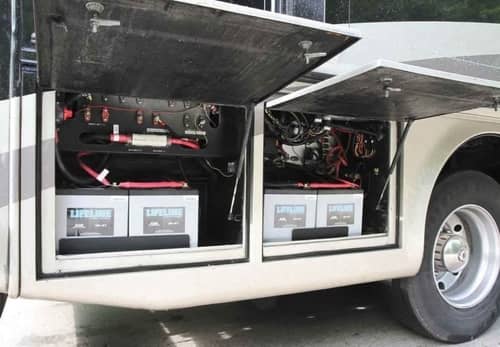
Regular battery maintenance in your RV depends on the battery model that you have in your vehicle. Different types of deep cycle batteries require different types of maintenance. As we pointed out earlier, lithium batteries do not require maintenance at all. Batteries also have different lifespans. For those who want to know what is the battery life for an RV, you must understand that this varies depending on whether you use deep-cycle batteries or lithium-ion batteries.
Therefore, be sure to refer to the vehicle manufacturer’s instructions for more detailed information on battery maintenance in your RV. That said, we bring you some basics related to the maintenance of RV batteries.
- Flooded-cell batteries maintain electrolyte levels. Flooded-cell batteries can with each charge cycle over the years lose water. This water must be replenished. Always use distilled water to reduce sulfation levels and form sulfate crystals that can appear when the plates of the battery are air-exposed. Check the batteries once per month at least. Ensure that they are always full before performing maintenance.
- Clean Battery terminals to remove built-up corrosion. You can do this by using a mixture of a gallon of water with one cup of baking soda. Also, you can use a battery close contact cleaning product in the commercial offer. For scrubbing use a toothbrush.
- A Sulfating level can rise if your batteries get too low in charge. Sulfating begins when your batteries charge falls below 80% or 12.4 volts. Make sure you recharge your batteries regularly after using them.
- Batteries need to be recharged often. Note, if you discharge RV batteries to 50% every day, they will last twice as long in comparison to when you discharged them each day to 20%. You should also be aware that overcharging and hot temperatures can also have negative effects on the battery.
The Best Way to Store RV Battery
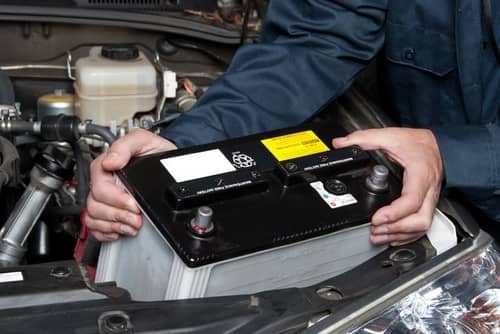
Now that you know the best way to charge your RV battery while driving, it’s important to learn how to properly the batteries. Many people do not use their recreational vehicles in winter, so in such situations, when the batteries are empty for a long time, they lose their capacity. Therefore, batteries should always be stored in the right way in order to last as long as possible and be at full capacity.
Before storing your RV battery for an extended period of time, follow these steps:
- First, be sure to charge your battery to 100%, and after unplug it from the vehicle’s connectors. Parasitic drainage will start if you keep your RV battery connected. Car components like the alarm, stereo, watch and others keep draining battery charge even when the engine is turned off.
- If you notice grime or corrosion on your RV battery, you must remove it. When you store the battery, corrosion or grime will appear and damage vital parts. Terminals should be cleaned thoroughly. You can even use a wire brush.
- Check how high are electrolytes and if it is necessary add distilled water. When the battery is charged the water dilates. To prevent overflow you must keep the level at less than 90%.
- The battery needs to be removed from the vehicle and properly store it. Best in a dry and cool place. The ideal temperature of storage is 32 to 80 degrees F.
- When you store the battery for a long period of time check it every now and then. To keep it running you must recharge it a minimum of once a week.
- Don’t recharge your battery immediately if it is frozen. The best is to take your RV and drive it to a mechanic. It can explode if you defrost it in the wrong way!
In the end, be sure to also watch this video to understand better this process.
FAQ: People Also Ask
How long do RV batteries last?
How long the battery in your RV will last depends on how often you use it, what type of battery you have, and how well you maintain it. Deep-cycle batteries can last 400 to 500 charge cycles while lithium-ion batteries can last up to 5,000 charges!
How many batteries does an RV or motorhome have?
Recreational vehicles have two separate battery systems – 120v AC system and 12v DC system. In addition, the vehicle has an extra automatic 12v system that serves to start the engine and basic functions. Just like in cars.
Final Thoughts
Today, RV vehicles can be easily recharged while you are driving. Following the same principle as charging the batteries that power the devices inside the RV, the trailer can also be charged. If you understand the principle of charging, you will also be able to apply it to other situations.
Before you go on the trip, make sure you understand everything we mentioned above in the text. Also, get the best available cables and connectors to keep your connection secure to avoid voltage drops, and to maximize power transfer. I hope that this article has helped you, and if you have any additional questions about RV batteries feel free to contact us.

Your article helped me a lot, is there any more related content? Thanks! https://accounts.binance.com/fr/register-person?ref=53551167